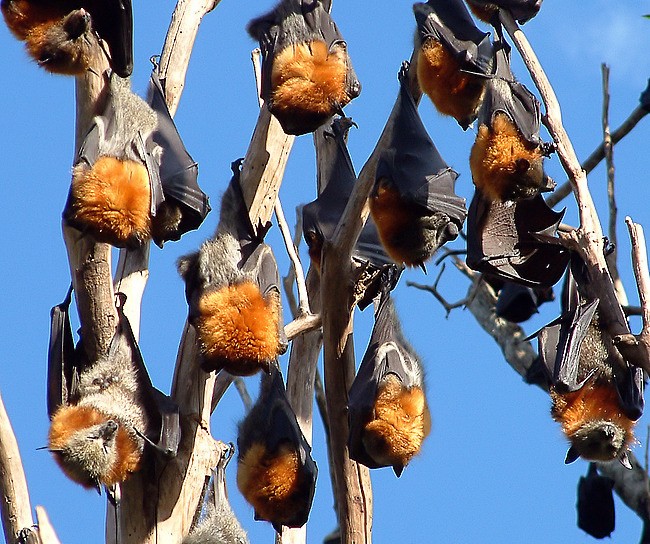Grey-headed flying fox
A species of Fruit bats Scientific name : Pteropus poliocephalus Genus : Fruit bats
Grey-headed flying fox, A species of Fruit bats
Scientific name: Pteropus poliocephalus
Genus: Fruit bats
Content
Description People often ask General Info
 Photo By Justin Welbergen , used under CC-BY-3.0 /Cropped and compressed from original
Photo By Justin Welbergen , used under CC-BY-3.0 /Cropped and compressed from original Description
The grey-headed flying fox is the largest bat in Australia. The overall colour of the pelage is a dark-grey body with a light-grey head, separated by a reddish-brown collar. The fur on the body is long and streaked with grey, the broad and well defined collar completely encircles the neck with hair that is golden orange in tone. A unique characteristic among bats of the genus Pteropus is fur on the legs that extends all the way to the ankle. Adults may have a wingspan reaching one metre in length and be up to one kilogram in weight. Weight generally varies between 600 and 1000 grams, with an average of 700 g. The combined length of the head and body is from 230 to 290 mm. The forearm length is a range from 138 to 180 mm. The length of the ear from the tip to base is 30 to 37 mm. Like many megachiropterans, the species lacks a tail. All of these bats possess claws on its first and second digits. The head is simple in form, with the characteristic 'dog-like' appearance of the genus. Since it does not echolocate, it lacks the tragus or leaf ornamentation found in many species of Microchiroptera. It relies on smell and, predominately, sight to locate its food (nectar, pollen and native fruits) and thus has relatively large eyes for a bat. The voice of P. poliocephalus consists of a complex series of squeals and screechings. They will flap their wings in hot weather, using blood pumped through the patagium to cool the body temperature. The grey-headed flying fox is long-lived for a mammal of its size. Individuals reportedly survived in captivity for up to 23 years, and a maximum age of up to 15 years seems possible in the wild. 
People often ask
General Info
Lifespan
15-23 years
Diet
Grey-headed flying fox primarily sustains itself on nectar, pollen, and fruits, making it a vital pollinator within its ecosystem. This species shows a preference for eucalyptus blooms, figs, and certain types of native fruits.
Appearance
Grey-headed flying fox is a large, fruit bat with a wingspan of up to a meter. Its striking appearance is characterized by its grey head and reddish-brown body, covered in glossy fur. Black, pointed wings extend from its shoulders down to its ankles. This species exhibits sexual dimorphism, with males typically possessing a reddish-brown neck collar which is absent in females.
Behavior
Grey-headed flying fox are social, nocturnal animals that live in large colonies. At dusk, they launch en masse in a spectacle known as 'fly out' for nightly foraging, primarily feeding on pollen and nectar. Highly territorial, they use scent marking for territory demarcation, showcasing significant vocal communication.
Population
Decreasing
Scientific Classification
Phylum
Chordates Class
Mammals Order
Bats Family
Megabats Genus
Fruit bats Species
Grey-headed flying fox